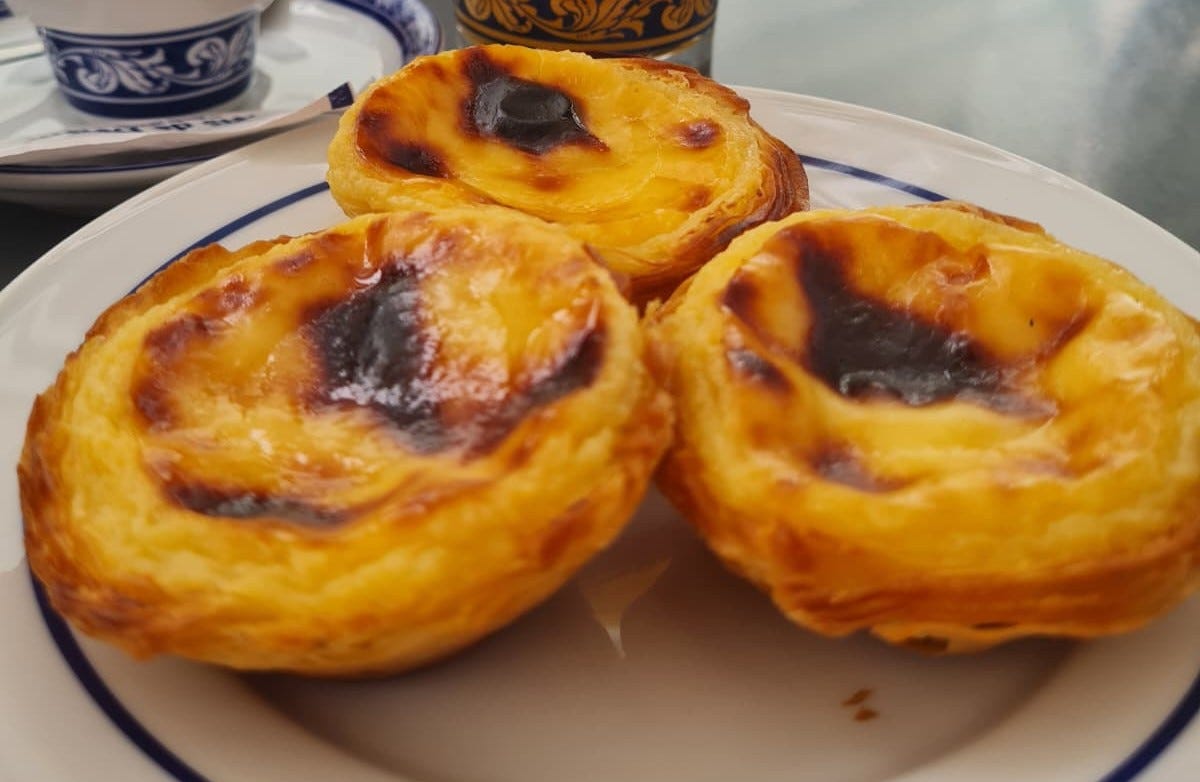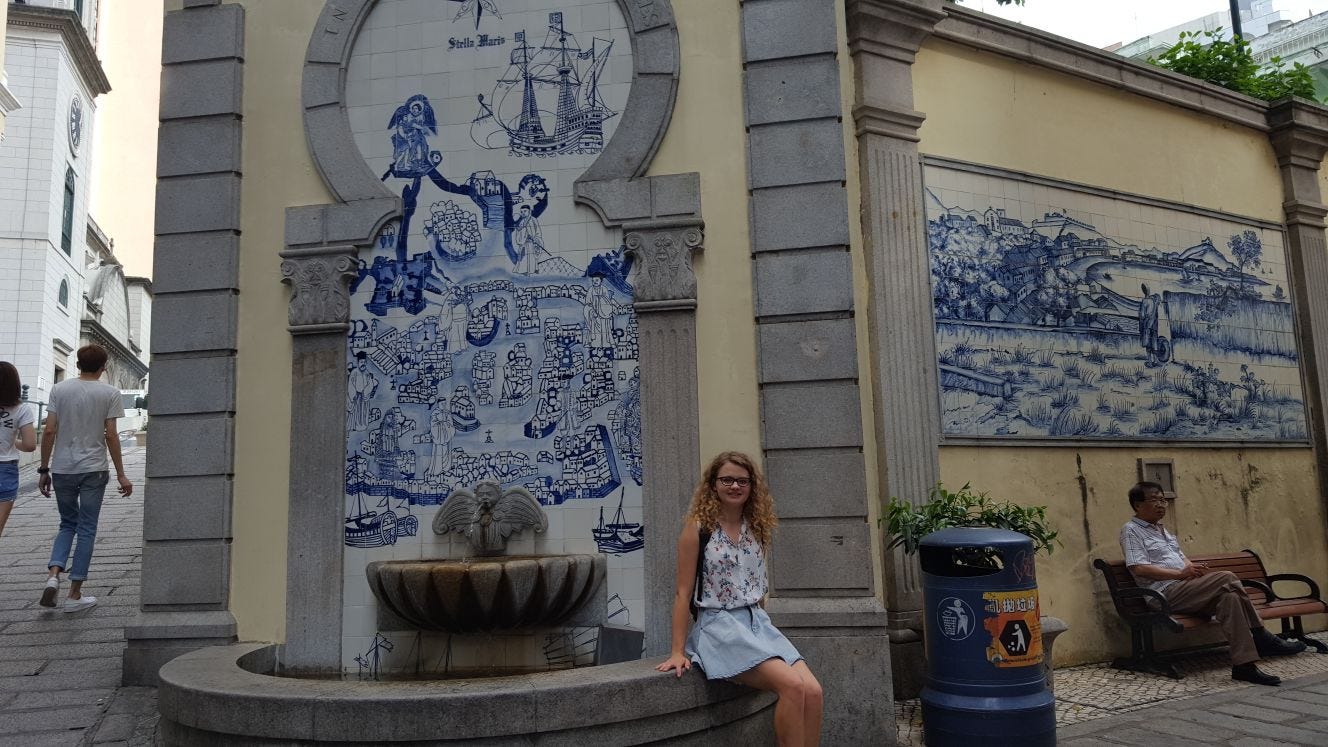From Portugal to China: The Journey of the Egg Tart
How a Portuguese Dessert Became Part of Chinese Cuisine 🇵🇹🇲🇴
Word of the week: 必尝美食 (bì cháng měishí)
Meaning: must-try delicacy
蛋挞是去澳门旅游必尝的美食。Dàntà shì qù Àomén lǚyóu bì cháng de měishí.
Translation: Egg tarts are a must-try food when traveling to Macau.
Did you know that China and Portugal share a love for the same dessert?
Back in the 16th century, when the Portuguese first arrived in China, they began a long-lasting process of cultural exchange by establishing their colony in Macau. Anyone who has visited Macau knows it is a unique blend of Portuguese and Chinese architecture and art. Yet one more thing stood out and eventually spread across China and the rest of Asia: pastel de nata, the Portuguese egg tart.
Let’s explore how the Portuguese egg tart became part of Macau’s cultural heritage. The text is written in a more literary style, so it’s a bit more advanced than our usual materials; but don’t worry, we’ve prepared extra vocabulary explanations this time.
路环是澳门最具乡村特色的一景,虽然距离酒店云集的金光大道只有4公里,却宛然换了个天地,林荫、平房、窄巷、小店浑然一体,充满了静谧悠然的气息。
路环 (Lùhuán) – Coloane (an island in Macau)
乡村特色 (xiāngcūn tèsè) – rural characteristics / rustic charm
景 (jǐng) – scene, view
云集 (yúnjí) – to gather in large numbers, to swarm
金光大道 (Jīnguāng Dàdào) – Cotai Strip (literally “Avenue of Golden Light”)
宛然 (wǎnrán) – as if, just like
天地 (tiāndì) – world, environment, realm
林荫 (línyīn) – tree shade / avenue shaded by trees
平房 (píngfáng) – single-story house / bungalow
窄巷 (zhǎi xiàng) – narrow alley
浑然一体 (húnrán yītǐ) – blended into a harmonious whole
静谧 (jìngmì) – quiet, tranquil
悠然 (yōurán) – leisurely, unhurried
气息 (qìxī) – breath, atmosphere, aura
Coloane is the most rustic corner of Macau. Although it lies only 4 kilometers from the hotel-packed Cotai Strip, it feels like an entirely different world—shaded by trees, dotted with low houses, narrow alleys, and little shops, all blending together in an atmosphere of quiet leisure.
坐落在其中的安德鲁饼店门面不大,远看去甚至并不起眼,唯一“出卖”其身份的就是一大早慕名而来的众多顾客。这也凸显了澳门的文化特色,既有金碧辉煌的酒店代表“档次格调”,又有接地气的独特商铺隐于市井。
坐落 (zuòluò) – to be situated, to be located
门面 (ménmiàn) – shop front, façade
不起眼 (bù qǐyǎn) – unremarkable, not eye-catching
出卖 (chūmài) – to reveal, to give away (here in quotation marks, figurative)
身份 (shēnfèn) – identity, status
慕名而来 (mù míng ér lái) – to come attracted by reputation
凸显 (tūxiǎn) – to highlight, to make stand out
金碧辉煌 (jīnbì huīhuáng) – resplendent, magnificent (lit. “gold and jade glittering”)
档次 (dàngcì) – grade, level, class
格调 (gédiào) – style, tone, character
接地气 (jiē dìqì) – down-to-earth, close to ordinary people
商铺 (shāngpù) – shop, store
市井 (shìjǐng) – marketplace, common streets of a town
Nestled within this setting, Lord Stow’s Bakery has a modest storefront that looks rather unremarkable from a distance; the only thing that “gives away” its identity is the crowd of eager visitors who arrive early in the morning. This contrast highlights Macau’s cultural character: on one side, there are lavish, glittering hotels representing luxury and style; on the other, down-to-earth, distinctive shops tucked away in the city’s everyday streets.
一块刚出炉的葡式蛋挞,酥脆的外皮配上表面黄黑相间的蛋奶馅料,一口咬下去,伴随着咔咔的响声,酥皮与馅料混合在嘴里,热气和浓郁的香甜奔涌而出,似乎充满了整个灵魂。“真的会爱上。”品尝的食客大多这样评价。
刚出炉 (gāng chūlú) – freshly baked, just out of the oven
葡式蛋挞 (Púshì dàntà) – Portuguese egg tart
酥脆 (sūcuì) – crispy and crunchy
外皮 (wàipí) – outer crust/skin
黄黑相间 (huáng hēi xiāngjiàn) – interlaced yellow and black (mottled golden-brown)
蛋奶馅料 (dànnǎi xiànliào) – egg-and-milk filling, custard filling
咔咔的响声 (kākā de xiǎngshēng) – crackling/crunching sound
混合 (hùnhé) – to mix, blend
浓郁 (nóngyù) – rich, strong (flavor or fragrance)
香甜 (xiāngtián) – fragrant and sweet
奔涌而出 (bēnyǒng ér chū) – to gush/rush out
灵魂 (línghún) – soul, spirit
品尝 (pǐncháng) – to taste, to savor
食客 (shíkè) – diner, customer
评价 (píngjià) – to comment, review, evaluate
A freshly baked Portuguese egg tart, with its crisp, flaky crust and custard filling mottled golden yellow and brown on top, gives off a delightful crackle as you bite into it. The crust and filling mingle in your mouth, releasing a surge of warmth and rich sweetness that seems to fill your very soul. “You’ll really fall in love with it,” is how most diners describe the experience.
既然在澳门做生意,便绕不开葡萄牙人这个消费者群体。这时,“葡挞”就进入安德鲁的视野。葡挞,即葡式蛋挞,是“蛋挞”这个大家族中的一员。所谓“挞”,是“tart”的粤语音译,指馅料外露的西式馅饼,与其相对应的是馅料被完全包裹密封的“派”。
既然 (jìrán) – since; now that
做生意 (zuò shēngyi) – to do business
绕不开 (rào bù kāi) – cannot avoid; can’t get around
消费者群体 (xiāofèi zhě qúntǐ) – consumer group
视野 (shìyě) – field of vision; view; perspective
大家族 (dà jiāzú) – big family; large group
音译 (yīnyì) – transliteration (based on sound)
馅料 (xiànliào) – filling (for pastries, dumplings, etc.)
外露 (wàilù) – exposed, visible
西式馅饼 (xīshì xiànbǐng) – Western-style pie/tart
相对应 (xiāng duìyìng) – corresponding; in contrast
包裹 (bāoguǒ) – to wrap up, to enclose
密封 (mìfēng) – sealed, airtight
Since doing business in Macau inevitably involves the Portuguese consumer group, “Portuguese egg tarts” soon entered Lord Stow’s line of sight. A pastel de nata, or Portuguese-style egg tart, is a member of the broader “egg tart” family. The word “挞” (taat3) is the Cantonese transliteration of “tart,” referring to Western-style pastries with exposed fillings, in contrast to the “pie” (pai), where the filling is completely enclosed within the crust.
用、牛奶、制成的蛋挞,在欧洲已有数百年的历史,在20世纪20年代便传到中国,结合了广东的“炖蛋”和酥皮点心技巧之后又传到香港,发展出了俗称的“港式蛋挞”。
制成 (zhìchéng) – to make into, to produce
已有 (yǐ yǒu) – already have (a history of…)
数百年 (shù bǎi nián) – several hundred years
20世纪20年代 (èrshí shìjì èrshí niándài) – the 1920s
传到 (chuándào) – to spread to, to be introduced to
结合 (jiéhé) – to combine, to integrate
广东 (Guǎngdōng) – Guangdong (province in southern China)
炖蛋 (dùn dàn) – steamed egg custard
酥皮点心 (sūpí diǎnxīn) – flaky pastry
技巧 (jìqiǎo) – technique, skill
俗称 (súchēng) – commonly known as
港式蛋挞 (Gǎngshì dàntà) – Hong Kong–style egg tart
Egg tarts, made with eggs, milk, and sugar, have a history of several centuries in Europe. They were introduced to China in the 1920s, where they merged with Cantonese traditions such as steamed egg custard and flaky pastry techniques, before spreading to Hong Kong and developing into what is popularly known as the “Hong Kong–style egg tart.”
在葡萄牙,相传早期的葡式蛋挞由200年前的修道院发明,因为蛋清是制作修女袍的原料,大量剩余的蛋黄弃之可惜,便被用来制作糕点。后来,买到蛋挞配方的饼店将之发扬光大。因为饼店在里斯本的贝伦区,这种葡式蛋挞又被称为“贝伦挞”,在今天依然是前往里斯本旅游的必尝美食。
相传 (xiāngchuán) – it is said; legend has it
早期 (zǎoqī) – early period
修道院 (xiūdàoyuàn) – monastery
发明 (fāmíng) – to invent
蛋清 (dànqīng) – egg white
修女袍 (xiūnǚ páo) – nun’s habit/robe
剩余 (shèngyú) – surplus; leftover
蛋黄 (dànhuáng) – egg yolk
弃之可惜 (qì zhī kěxī) – a pity to throw away
糕点 (gāodiǎn) – pastry, dessert
配方 (pèifāng) – recipe, formula
发扬光大 (fāyáng guāngdà) – to carry forward and popularize
里斯本 (Lǐsīběn) – Lisbon
贝伦区 (Bèilún Qū) – Belém district
必尝美食 (bì cháng měishí) – must-try delicacy
In Portugal, it is said that the early Portuguese egg tart was invented about 200 years ago in a monastery. Since egg whites were used to make nuns’ habits, large quantities of leftover egg yolks would have gone to waste, so they were instead used to make pastries. Later, a bakery that acquired the recipe further popularized it. Because the shop was located in Lisbon’s Belém district, this Portuguese egg tart came to be known as the “Pastel de Belém,” and to this day it remains a must-try delicacy for anyone visiting Lisbon.
Have you tried the egg tart in China? Let us know in the comments!
Antoine & Dorota
Referenced author(s): 环球时报









Best egg tarts I’ve ever had were in Beijing! I’ve never found better. So I try them wherever I go just to check if they are as good🩷
It's true! Macao egg tarts are so good!